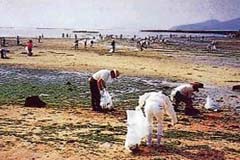|
| Governmental activities |
Japan |
| Name of Activity |
Overview |
| Selected 100 Exquisite and Well-conserved Waters |
 “Selected 100 Exquisite and Well-conserved Waters” were chosen by the Environment Agency (presently Ministry of the Environment) in March 1985. “Selected 100 Exquisite and Well-conserved Waters” were chosen by the Environment Agency (presently Ministry of the Environment) in March 1985.- The main objective is to raise consciousness of clear nearby waters, which have been familiar to residents from the past and conserved by the people, through rediscovering those waters in all Japan.
|
| Seto Inland Sea Environmental Conservation Month |
 Every year, month of June is observed as the “Seto Inland Sea Environmental Conservation Month” Every year, month of June is observed as the “Seto Inland Sea Environmental Conservation Month”- It aim to disseminate knowledge and raise consciousness about environmental issues of the Seto Inland Sea
- Various activities such as seminars, lectures, seashore clean-up campaigns and distribution of posters are promoted during this month at many places in the 13 prefectures surrounding the Seto Inland Sea.
|
| Municipal-level Monitoring Project of Biological Indices in Rivers |
- In cooperation with municipal organizations, the Ministry of the Environment and the Ministry of Land, Infrastructure and Transport have widely appealed for public participation since fiscal year 1984. The aquatic life monitoring is carried out in rivers of all Japan by elementary and junior high school students and citizen’s groups.
- The water quality judgment manual “Water Quality Judgment by Aquatic Life—Let’s investigate creatures in the river” is being created.
- The number of biological indices is 30.
|
| The 88 Bests in Bathing Spot in Japan |
 “The 88 Bests in Bathing Spot in Japan” aims
to familiarize bathing spots with good quality
water and pleasant environment. In 2001, 88 bathing
spots were selected by the committee on pleasant
bathing spots. “The 88 Bests in Bathing Spot in Japan” aims
to familiarize bathing spots with good quality
water and pleasant environment. In 2001, 88 bathing
spots were selected by the committee on pleasant
bathing spots.- The 88 bests in bathing spot in Japan were reselected
with revised selecting standards, based on “The
55 Bests in Bathing Spot in Japan” selected
in 1998. “The 55 Bests in Bathing Spot in
Japan” honored 55 bathing spots with good
quality water and pleasant environment to:
- further understanding and cooperation
on the conservation of the water environment
through contact with water
- support related groups’ efforts
to make the bathing spots better.
- Each of
the 88 selected bathing spots had either
more than 10,000(bathing beach) or over 5,000
visitors (lake, marsh and river) last year, and has
also satisfied some requirements set such as water
quality.
- The committee on pleasant bathing spots selected
88 bathing spots out from 146 bathing
spots nominated by prefectures, considering
their water quality, natural environment, scenery,
safety, convenience and advantages as
well as consideration for the environment.
|
| “Kodomo Hotaranger” |
 “Kodomo Hotaranger” is an award
for water environment conservation activity, which
is related to fireflies (hotaru) and participated
in mainly by children (kodomo). It is
children who will shoulder the next generation; “Kodomo
Hotaranger” aims to raise children’s
awareness of water environment conservation through
protecting fireflies, which spend most of their
lifetime at the waterside. “Kodomo Hotaranger” is an award
for water environment conservation activity, which
is related to fireflies (hotaru) and participated
in mainly by children (kodomo). It is
children who will shoulder the next generation; “Kodomo
Hotaranger” aims to raise children’s
awareness of water environment conservation through
protecting fireflies, which spend most of their
lifetime at the waterside. - “Kodomo Hotaranger” started in 2004
and is working under the auspices of the Ministry
of the Environment and the Earth Water & Green
Foundation.
- After being judged by the jury, 2 activities
are chosen to be awarded the Minister of
the Environment prize and the excellence prize
from submitted reports on water environment conservation
activities concerning fireflies by the Minister
of the Environment.
- The judgment is done, taking
many points into consideration; not only
outcomes of activities and the extent of water-environmental
awareness got, but also autonomy, the
extent of revitalization of a local community, originality,
pleasantness, continuity, possibilities
and the quality of children’s experiences got are
taken into account.
|
< back
|
